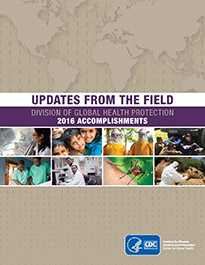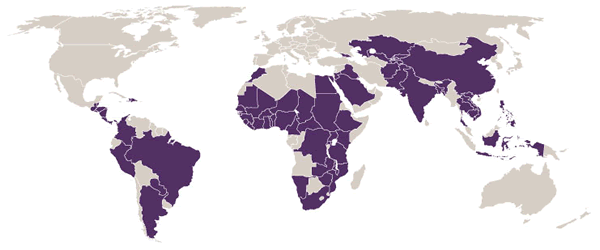About the Division of Global Health Protection (DGHP)
What We Do: Prevent. Detect. Respond.
Stopping outbreaks at the source. Protecting America’s future 24/7.
Ebola. Zika. Flu. Global health protection is about more than one country or one issue.
Many factors threaten our health, safety, and economy, including infectious diseases, bioterrorist threats, natural or man-made disasters, and the growing burden of noncommunicable diseases.
CDC’s Division of Global Health Protection (DGHP) works 24/7 to protect Americans from dangerous health threats around the world. Our scientists and “boots on the ground” frontline responders help contain outbreaks overseas so they don’t reach our shores.
Why It’s Important
We live in a highly mobile and connected world, where the impact of health threats reaches farther and wider than ever. We know that a disease can be transported from an isolated rural village to any major city in as little as 36 hours.1 An outbreak anywhere is a threat everywhere.
We must be able to act quickly. If an outbreak is not detected early and controlled, it can spread rapidly – causing huge loss of life, devastating entire health systems and economies, stalling future development, and even leading to political instability. Speed, combined with strong science, laboratories, and technical experience, saves lives and better protects Americans from the dangers of disease outbreaks, no matter where they occur.
Updates from the Field

The quarterly newsletter from the Division of Global Health Protection features investigation highlights, ongoing partnership work, and projects for building capacities.
We can’t predict exactly where or when the next epidemic will begin, or what it will be—but we know it could happen at any time. We have seen the emergence of deadly new pathogens that have spread like wildfire and the reemergence of diseases we thought were under control. In addition to naturally occurring disease, outbreaks can also begin through accidental release of a pathogen or as an intentional act of bioterrorism.
Every outbreak, large or small, comes with a price tag. Economies can be hit hard with the growing cost of controlling diseases, and the private sector often bears much of this burden, suffering from decreased travel and tourism, lost business continuity, increases in health care costs, and disrupted trade with international markets. An independent analysis of current global health systems, from the Commission on a Global Health Risk Framework for the Future estimates that the cost of a global pandemic would be $6 trillion (USD).2
We need protection in place before the next disaster strikes. Countries need strong everyday programs that can be scaled up to meet the demands of an emergency. Weak health systems anywhere leave openings for disease to take root and spread, turning local outbreaks into global epidemics.
How We Do It
DGHP works with its partners to protect the U.S. from deadly and costly public health crises, whether they begin in the U.S. or elsewhere. As the nation’s premier public health agency, CDC is leading our country and others to meet international standards for global health security. The knowledge and experience we share is already being used to stop outbreaks faster in other countries.
Every day, our staff and programs protect the health and safety of Americans and people around the world.
- We strive to increase the security of the world’s health through the Global Health Security Agenda, a worldwide effort to strengthen every country’s capacity to prevent, detect, and respond to health threats.
- We monitor new and emerging diseases 24/7 through our Global Disease Detection Operations Center in Atlanta and through Global Disease Detection programs across the globe.
- We extend in-country surveillance and build a global workforce of disease detectives through our Field Epidemiology Training Program.
- We support countries during health emergencies through our Emergency Response and Recovery activities.
- We share resources with existing programs to reduce noncommunicable diseases caused by hypertension and tobacco use.
- We train staff to manage emergency operations centers so they can respond quickly to outbreaks.
- We gather and use relevant health information through surveys and data sharing initiatives.
- We create National Public Health Institutes around the world that serve as a home for public health expertise.
Advancing global health security
Global health security means having the public health capacity to identify health threats, stop outbreaks from becoming epidemics, and save lives. The countries of the world have joined together under two international frameworks to commit to global health security worldwide: the International Health Regulations (IHR)3, which were revised by the global community in 2005, and the (GHSA), an international agreement signed in 2014.
DGHP helps partner countries meet their obligations to these agreements through leading GHSA implementation and engagement efforts for CDC. We work in partnership with nearly 60 GHSA partner nations to identify health emergencies, track dangerous diseases, and rapidly respond to outbreaks or other public health threats. Our focus is on supporting four critical areas related to sustainable public health systems: laboratories, surveillance (tracking and monitoring disease), workforce development, and preparedness and emergency management.
To measure progress towards global health security, CDC and its partners developed the Joint External Evaluation (JEE). The JEE is a voluntary evaluation process that gives countries a starting point by identifying strengths and addressing the most urgent needs within their health systems.
Where We Work
DGHP’s collaborations and programs span the globe. We work alongside key CDC programs; other U.S. government agencies; ministries of health; and international organizations to promote mutual strategies, research, and policies to ensure that more than 70 countries build core public health capacities and address gaps in emergency preparedness and response.

Map of Division's Global Presence World map showing the Division's global presence; we currently work in over 70 countries as of February 2016.
Fast Facts
- The Global Disease Detection Operations Center monitors 30-40 outbreaks in other countries each day.
- Our Field Epidemiology Training Program has trained more than 10,000 disease detectives in outbreak investigation and response in over 70 countries.
- We have helped stand up national public health institutes in ten countries, with another seven expected to become functional in 2017.
- We rapidly responded to and successfully extinguished seven flare-ups of Ebola in West Africa. We are helping to build broader core public health capacity in the Ebola-affected countries (Guinea, Sierra Leone, and Liberia) to prevent future outbreaks of Ebola.
- Working with our global health security partners, we have supported in over 30 countries.
- We partnered with the World Health Organization to launch the Global Hearts Initiative, which supports governments in strengthening cardiovascular disease prevention and control.
References
- Jonas, Olga B. Pandemic Risk. World Bank, Washington, DC. © World Bank. https://openknowledge.worldbank.org/handle/10986/16343 License: CC BY 3.0 IGO.
- Gostin LO, Mundaca-Shah CC, Kelley PW. Neglected Dimensions of Global Security: The Global Health Risk Framework Commission. JAMA. 2016;315(14):1451-1452. doi:10.1001/jama.2016.1964.
- WHO. Strengthening health security by implementing the International Health Regulations (2005). Page accessed 5/12/2017.
- Page last reviewed: May 11, 2017
- Page last updated: May 11, 2017
- Content source:


 ShareCompartir
ShareCompartir